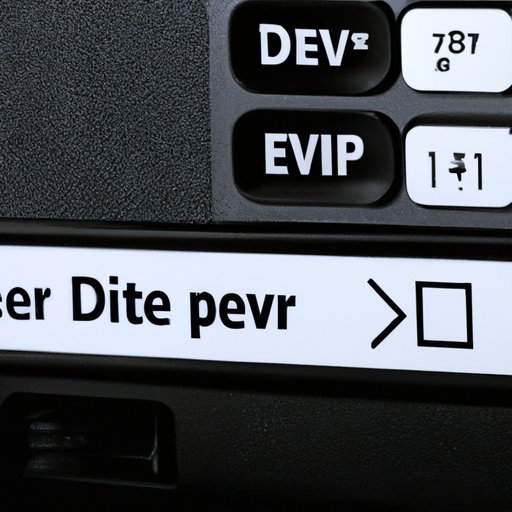I. Introduction
If you’ve ever experienced slow system performance, software crashes, or other inexplicable issues on your PC, the problem might be outdated drivers. Drivers are software that helps your computer hardware communicate with the operating system, and keeping them up to date is essential for optimal performance and stability. In this article, we’ll explore how to update drivers on your PC and share tips for doing it safely and efficiently.
II. Why Update Your Drivers?
Drivers can sometimes cause performance or stability issues on your computer if they become outdated. This is because older drivers often cannot work effectively with new operating systems or software updates. Outdated drivers can also pose security risks to your system as they may contain vulnerabilities that could be exploited by attackers. To avoid these problems, it is essential to update your drivers regularly.
III. Step-by-step guide
There are several ways to update your drivers, and the easiest is to use Device Manager, a built-in utility in Windows. To access Device Manager, follow these steps:
- Press the Windows key + X and click on Device Manager from the Quick Link menu.
- Locate the device you want to update in the list and expand it by clicking on the arrow next to it.
- Right-click the device and select ‘Update driver’ from the context menu.
- Select ‘Search automatically for updated driver software’ and let the system search for the latest driver version.
- Once the new driver is detected, follow the on-screen instructions to install it.
If Device Manager fails to find the latest driver, you can manually download and install it from the manufacturer’s website. To do this, follow these additional steps:
- Go to the manufacturer’s website and download the latest version of the driver for your device and your operating system version.
- Locate the downloaded file, extract its contents, and run the setup file.
- Follow the on-screen instructions to complete the installation.
While updating drivers can be a smooth process, sometimes problems may arise. For example, the new driver may not be compatible with your current hardware or software configuration. In such cases, it’s advisable to restore the previous drivers. You can do this by following these steps:
- Open Device Manager and locate the device with the updated driver.
- Right-click the device and select Properties from the context menu.
- In the Properties window, select the Driver tab and click Roll Back Driver.
- Follow the on-screen instructions to restore the previous driver version.
IV. Using Third-Party Software
If the manual process seems too complicated, you may want to consider using a third-party software program. These software programs can automatically detect outdated drivers and update them with a few clicks. Some popular driver update software includes DriverMax, Driver Booster, and Snappy Driver Installer. These tools come with the added benefit of automatically detecting and installing the latest drivers, saving you time and effort.
V. Safety Tips
Updating drivers always comes with some risks, so it’s important to take precautions to avoid issues. Before making any changes to your system, always create a system restore point. This allows you to go back to the previous saved state if anything goes wrong. Additionally, avoid downloading drivers from untrusted sources as they may contain malware or viruses. Stick to downloading drivers from reputable sources such as manufacturers’ websites or trusted driver update software.
VI. Troubleshooting Tips
While updating drivers, you might encounter some issues such as error messages or conflicts. In such cases, try uninstalling and reinstalling the driver or updating other related drivers. If the problem persists, contact the manufacturer’s technical support for further assistance. Some common error messages you may encounter while updating drivers include the ‘No driver found’ error, ‘The installing driver is not valid’, or ‘Unable to verify the digital signature of the driver’ error.
VII. The Importance of Regular Updates
As we’ve mentioned earlier in this article, updating your drivers regularly can improve your computer’s performance, stability, and security. Outdated drivers can slow down your system, cause software conflicts, or even expose your device to cyber threats. So, try to check for updates at least once every few months and install them immediately. This is especially important for critical drivers like those for graphics cards or sound cards.
VIII. Prioritizing Updates
Not all drivers are equally important, so it’s best to prioritize updates based on their criticality. For example, updating graphics card drivers can significantly enhance your system’s graphics performance. Some critical drivers you might want to update include motherboard chipset drivers, network drivers, and storage drivers. You can also use driver update software to easily prioritize and update important drivers.
IX. Frequently Asked Questions
Q. What are drivers?
A. Drivers are software programs that communicate between your hardware and operating system. They control your device’s functionality and performance.
Q. What is the difference between automatic and manual driver updates?
A. Automatic driver updates are done by using driver update software that scans and updates drivers automatically, while manual driver updates require you to download and install the latest drivers manually.
Q. How can I check which drivers need updating?
A. You can check for outdated drivers in Device Manager, use a driver update software, or manually check the manufacturers’ website for updated drivers.
X. Conclusion
Keeping your drivers up to date is essential for optimal system performance, stability, and security. The steps we’ve outlined in this article should help you easily update your drivers and avoid common issues. Remember to create a system restore point before updating drivers and be cautious of untrusted sources. Make sure to prioritize important drivers for updates and check for updates regularly.
